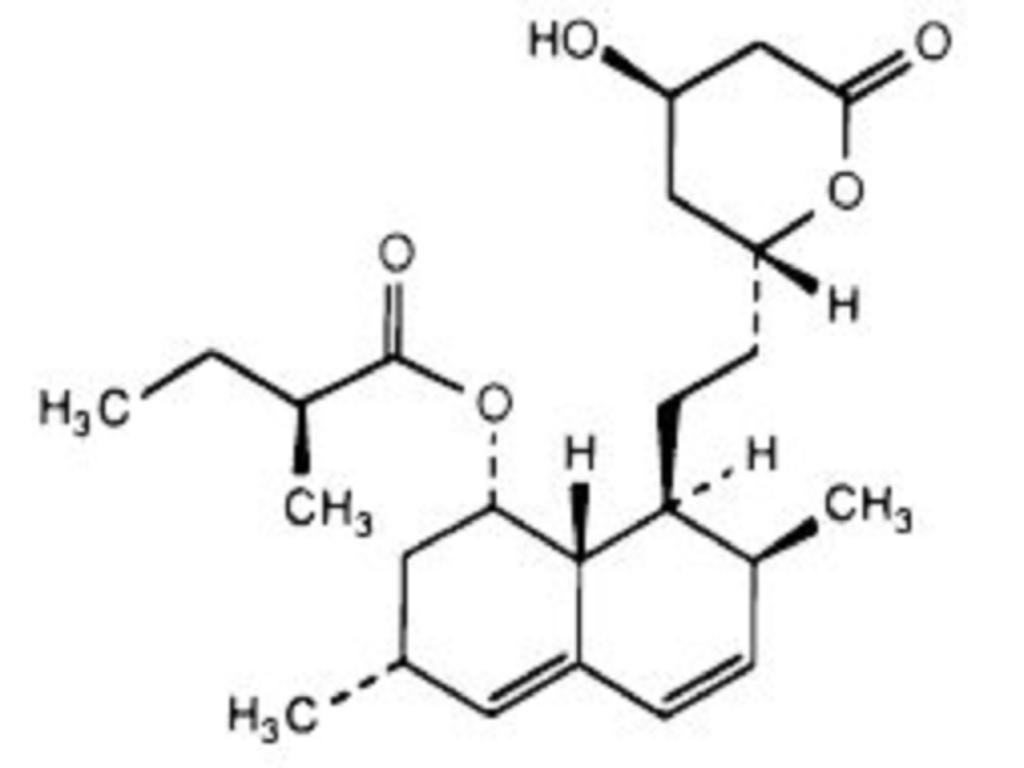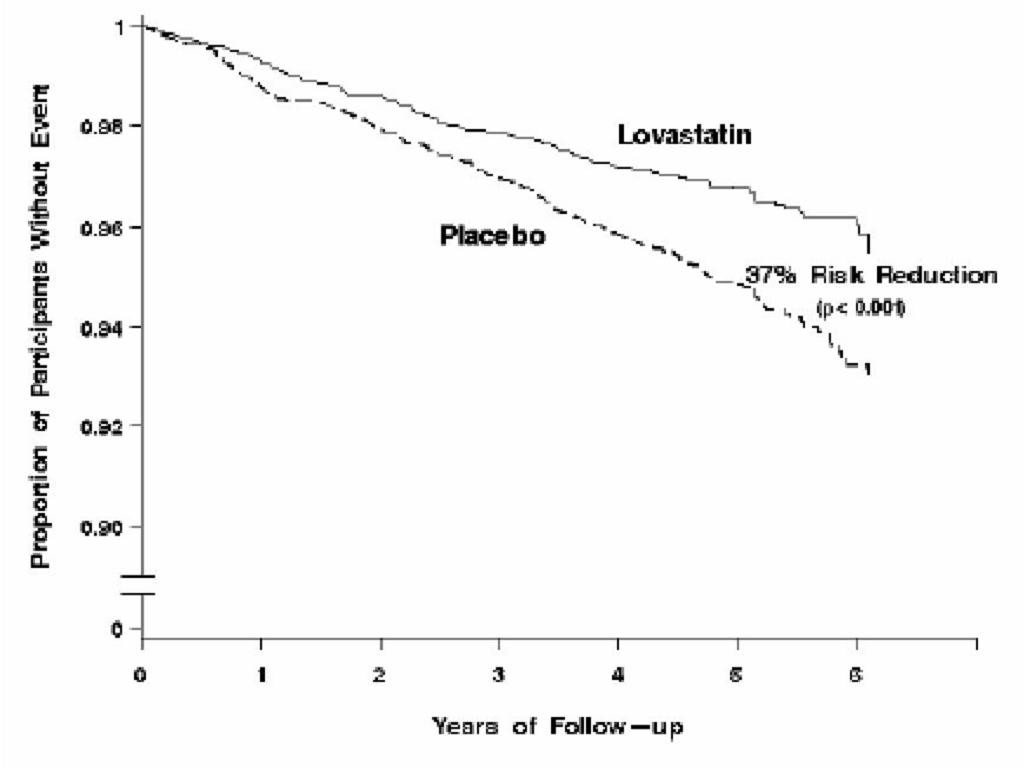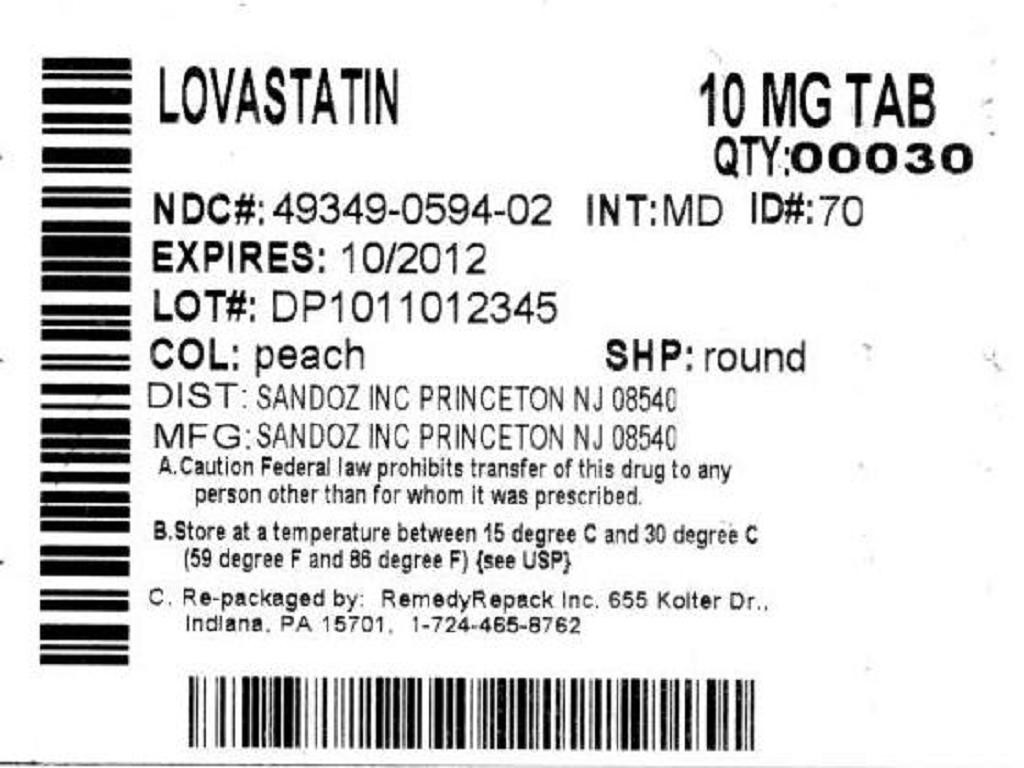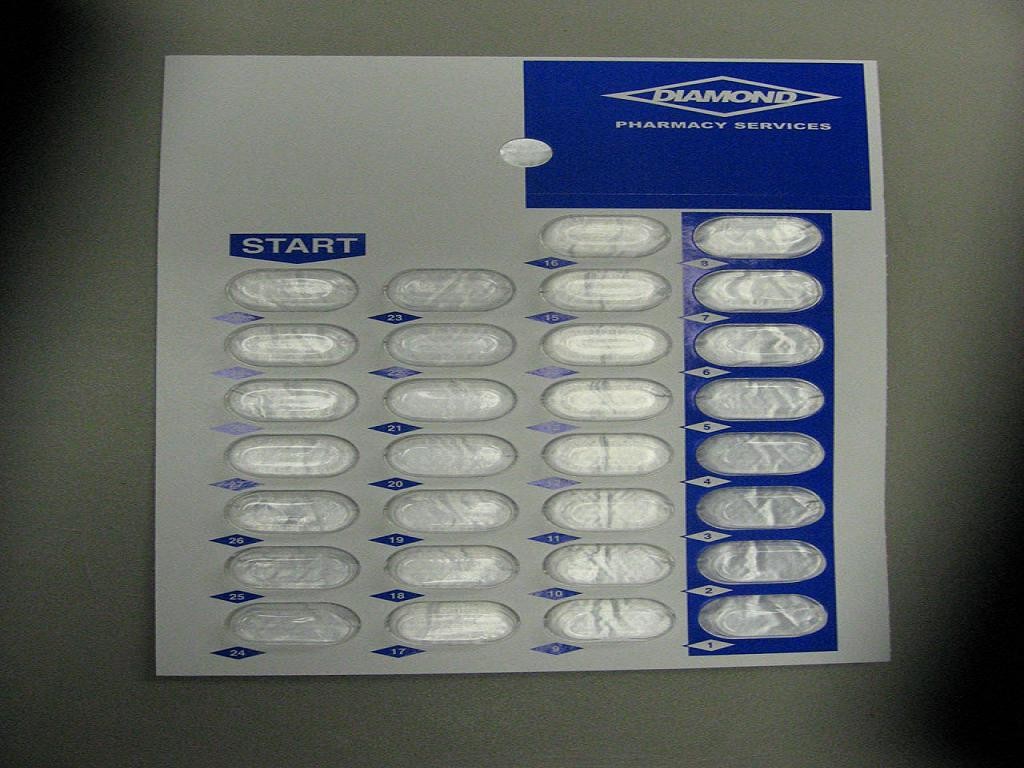Lovastatin
FULL PRESCRIBING INFORMATION: CONTENTS*
- LOVASTATIN DESCRIPTION
- CLINICAL PHARMACOLOGY
- PHARMACOKINETICS
- CLINICAL STUDIES
- INDICATIONS & USAGE
- LOVASTATIN CONTRAINDICATIONS
- WARNINGS
- PRECAUTIONS
- INFORMATION FOR PATIENTS
- DRUG INTERACTIONS
- CARCINOGENESIS & MUTAGENESIS & IMPAIRMENT OF FERTILITY
- PREGNANCY
- NURSING MOTHERS
- PEDIATRIC USE
- GERIATRIC USE
- LOVASTATIN ADVERSE REACTIONS
- OVERDOSAGE
- DOSAGE & ADMINISTRATION
- HOW SUPPLIED
- STORAGE AND HANDLING
- PACKAGE LABEL.PRINCIPAL DISPLAY PANEL SECTION
FULL PRESCRIBING INFORMATION
LOVASTATIN DESCRIPTION

CLINICAL PHARMACOLOGY
Clinical Studies in Adults
PHARMACOKINETICS
Geriatric Use
Myopathy/RhabdomyolysisDrug Interactions
Drug Interactions
CLINICAL STUDIES
Clinical Studies in Adults
Expanded Clinical Evaluation of Lovastatin (EXCEL) Study
**
Air Force/Texas Coronary Atherosclerosis Prevention Study (AFCAPS/TexCAPS)

Atherosclerosis
Eye
Clinical Studies in Adolescent Patients
Efficacy of Lovastatin in Adolescent Boys with Heterozygous Familial Hypercholesterolemia
**
Efficacy of Lovastatin in Post-menarchal Girls with Heterozygous Familial Hypercholesterolemia
**
INDICATIONS & USAGE
Primary Prevention of Coronary Heart Disease
CLINICAL PHARMACOLOGY
Coronary Heart Disease
Hypercholesterolemia
1
1
Adolescent Patients with Heterozygous Familial Hypercholesterolemia
General Recommendations
*NCEP Treatment Guidelines: LDL-C Goals and Cutpoints for Therapeutic Lifestyle Changes and Drug Therapy in Different Risk CategoriesRisk CategoryLDL Goal (mg/dL)LDL Level at Which to Initiate Therapeutic Lifestyle Changes (mg/dL)LDL Level at Which to Consider Drug Therapy (mg/dL)CHD*or CHD risk equivalents (10-year risk >20%)<100(100 to 129: drug optional)2+ Risk Factors (10-year risk<13010-year risk 10-20%:10-year risk <10%:0 to 1 Risk factor<160(160 to 189: LDL-lowering drug optional)After the LDL-C goal has been achieved, if the TG is stillmg/dL, non HDL-C (total-C minus HDL-C) becomes a secondary target of therapy. Non-HDL-C goals are set 30 mg/dL higher than LDL-C goals for each risk category.
At the time of hospitalization for an acute coronary event, consideration can be given to initiating drug therapy at discharge if the LDL-C ismg/dL (see NCEP Guidelines above).
Since the goal of treatment is to lower LDL-C, the NCEP recommends that LDL-C levels be used to initiate and assess treatment response. Only if LDL-C levels are not available, should the total-C be used to monitor therapy.
Although lovastatin tablets USP may be useful to reduce elevated LDL-C levels in patients with combined hypercholesterolemia and hypertriglyceridemia where hypercholesterolemia is the major abnormality (Type IIb hyperlipoproteinemia), it has not been studied in conditions where the major abnormality is elevation of chylomicrons, VLDL or IDL (i.e., hyperlipoproteinemia types I, III, IV, or V).***
*** Classification of Hyperlipoproteinemias
Lipid ElevationsTypeLipoproteins elevatedmajorminorIchylomicronsTGIIaLDLCIIbLDL, VLDLCTGIII (rare)IDLC/TGIVVLDLTGV (rare)chylomicrons, VLDLTGIDL = intermediate-density lipoprotein.
The NCEP classification of cholesterol levels in pediatric patients with a familial history of hypercholesterolemia or premature cardiovascular disease is summarized below:
CategoryTotal-C (mg/dL)LDL-C (mg/dL)Acceptable<170<110Borderline170 to 199110 to 129HighChildren treated with lovastatin in adolescence should be re-evaluated in adulthood and appropriate changes made to their cholesterol-lowering regimen to achieve adult goals for LDL-C.
LOVASTATIN CONTRAINDICATIONS
WARNINGS
Pregnancy and Lactation
PregnancyNursing Mothers
Lovastatin should be administered to women of childbearing age only when such patients are highly unlikely to conceive.Pregnancy
WARNINGS
Myopathy/RhabdomyolysisAs with other HMG-CoA reductase inhibitors, the risk of myopathy/ rhabdomyolysis is dose related.
All patients starting therapy with lovastatin, or whose dose of lovastatin is being increased, should be advised of the risk of myopathy and told to report promptly any unexplained muscle pain, tenderness or weakness. Lovastatin therapy should be discontinued immediately if myopathy is diagnosed or suspected.
The risk of myopathy/rhabdomyolysis is increased by concomitant use of lovastatin with the following:
Potent inhibitors of CYP3A4:
The use of lovastatin concomitantly with the potent CYP3A4 inhibitors itraconazole, ketoconazole, erythromycin, clarithromycin, telithromycin, HIV protease inhibitors, nefazodone, or large quantities of grapefruit juice (>1 quart daily) should be avoided.
Gemfibrozil, particularly with higher doses of lovastatin: The dose of lovastatin should not exceed 20 mg daily in patients receiving concomitant medication with gemfibrozil. The combined use of lovastatin with gemfibrozil should be avoided, unless the benefits are likely to outweigh the increased risks of this drug combination.
Other lipid-lowering drugs (other fibrates org/day of niacin): The dose of lovastatin should not exceed 20 mg daily in patients receiving concomitant medication with other fibrates org/day of niacin.The benefit of further alterations in lipid levels by the combined use of lovastatin with other fibrates or niacin should be carefully weighed against the potential risks of these combinations.
Cyclosporine or danazol, with higher doses of lovastatin: The dose of lovastatin should not exceed 20 mg daily in patients receiving concomitant medication with cyclosporine or danazol.
Amiodarone or verapamil: The dose of lovastatin should not exceed 40 mg daily in patients receiving concomitant medication with amiodarone or verapamil.
Liver Dysfunction
Persistent increases (to more than 3 times the upper limit of normal) in serum transaminases occurred in 1.9% of adult patients who received lovastatin for at least one year in early clinical trialsADVERSE REACTIONSCLINICAL PHARMACOLOGYADVERSE REACTIONS
ADVERSE REACTIONS
PRECAUTIONS
GeneralWARNINGSADVERSE REACTIONS
Homozygous Familial Hypercholesterolemia
ADVERSE REACTIONS
INFORMATION FOR PATIENTS
Patients should be advised about substances they should not take concomitantly with lovastatin and be advised to report promptly unexplained muscle pain, tenderness, or weakness (see list below and WARNINGS,Myopathy/Rhabdomyolysis). Patients should also be advised to inform other physicians prescribing a new medication that they are taking lovastatin.DRUG INTERACTIONS
CYP3A4 Interactions
See WARNINGS,Myopathy/Rhabdomyolysisand CLINICAL PHARMACOLOGY,Pharmacokinetics.
Itraconazole
Ketoconazole
Erythromycin
Clarithromycin
Telithromycin
HIV protease inhibitors
Nefazodone
Large quantities of grapefruit juice (>1 quart daily)
Interactions with lipid-lowering drugs that can cause myopathy when given alone
See WARNINGS-Myopathy/Rhabdomyolysis.
Gemfibrozil
Other fibrates
Niacin (nicotinic acid) (>1 g/day)
Other Drug Interactions
Cyclosporine or Danazol
Myopathy/RhabdomyolysisPharmacokinetics.).
Amiodarone or Verapamil
The risk of myopathy/rhabdomyolysis is increased when either amiodarone or verapamil is used concomitantly with a closely related member of the HMG-CoA reductase inhibitor class (see WARNINGS,Myopathy/Rhabdomyolysis).
Coumarin Anticoagulants
In a small clinical trial in which lovastatin was administered to warfarin treated patients, no effect on prothrombin time was detected. However, another HMG-CoA reductase inhibitor has been found to produce a less than two-second increase in prothrombin time in healthy volunteers receiving low doses of warfarin. Also, bleeding and/or increased prothrombin time have been reported in a few patients taking coumarin anticoagulants concomitantly with lovastatin. It is recommended that in patients taking anticoagulants, prothrombin time be determined before starting lovastatin and frequently enough during early therapy to insure that no significant alteration of prothrombin time occurs. Once a stable prothrombin time has been documented, prothrombin times can be monitored at the intervals usually recommended for patients on coumarin anticoagulants. If the dose of lovastatin is changed, the same procedure should be repeated. Lovastatin therapy has not been associated with bleeding or with changes in prothrombin time in patients not taking anticoagulants.
Propranolol
In normal volunteers, there was no clinically significant pharmacokinetic or pharmacodynamic interaction with concomitant administration of single doses of lovastatin and propranolol.
Digoxin
In patients with hypercholesterolemia, concomitant administration of lovastatin and digoxin resulted in no effect on digoxin plasma concentrations.
Oral Hypoglycemic Agents
In pharmacokinetic studies of lovastatin in hypercholesterolemic non-insulin dependent diabetic patients, there was no drug interaction with glipizide or with chlorpropamide (see clinical studies underCLINICAL PHARMACOLOGY).
Endocrine Function
HMG-CoA reductase inhibitors interfere with cholesterol synthesis and as such might theoretically blunt adrenal and/or gonadal steroid production. Results of clinical trials with drugs in this class have been inconsistent with regard to drug effects on basal and reserve steroid levels. However, clinical studies have shown that lovastatin does not reduce basal plasma cortisol concentration or impair adrenal reserve, and does not reduce basal plasma testosterone concentration. Another HMG-CoA reductase inhibitor has been shown to reduce the plasma testosterone response to HCG. In the same study, the mean testosterone response to HCG was slightly but not significantly reduced after treatment with lovastatin 40 mg daily for 16 weeks in 21 men. The effects of HMG-CoA reductase inhibitors on male fertility have not been studied in adequate numbers of male patients. The effects, if any, on the pituitary-gonadal axis in pre-menopausal women are unknown. Patients treated with lovastatin who develop clinical evidence of endocrine dysfunction should be evaluated appropriately. Caution should also be exercised if an HMG-CoA reductase inhibitor or other agent used to lower cholesterol levels is administered to patients also receiving other drugs (e.g., ketoconazole, spironolactone, cimetidine) that may decrease the levels or activity of endogenous steroid hormones.
CNS Toxicity
Lovastatin produced optic nerve degeneration (Wallerian degeneration of retinogeniculate fibers) in clinically normal dogs in a dose-dependent fashion starting at 60 mg/kg/day, a dose that produced mean plasma drug levels about 30 times higher than the mean drug level in humans taking the highest recommended dose (as measured by total enzyme inhibitory activity). Vestibulocochlear Wallerian-like degeneration and retinal ganglion cell chromatolysis were also seen in dogs treated for 14 weeks at 180 mg/kg/day, a dose which resulted in a mean plasma drug level (Cmax) similar to that seen with the 60 mg/kg/day dose.
CNS vascular lesions, characterized by perivascular hemorrhage and edema, mononuclear cell infiltration of perivascular spaces, perivascular fibrin deposits and necrosis of small vessels, were seen in dogs treated with lovastatin at a dose of 180 mg/kg/day, a dose which produced plasma drug levels (Cmax) which were about 30 times higher than the mean values in humans taking 80 mg/day. Similar optic nerve and CNS vascular lesions have been observed with other drugs of this class.
Cataracts were seen in dogs treated for 11 and 28 weeks at 180 mg/kg/day and 1 year at 60 mg/kg/day.
CARCINOGENESIS & MUTAGENESIS & IMPAIRMENT OF FERTILITY
PREGNANCY
Pregnancy Category XCONTRAINDICATIONS
CONTRAINDICATIONS
NURSING MOTHERS
CONTRAINDICATIONSPEDIATRIC USE
Doses greater than 40 mg have not been studied in this population.Clinical Studies in Adolescent PatientsAdolescent Patients (ages 10 to 17 years)Adolescent Patients (10 to 17 years of age) with Heterozygous Familial Hypercholesterolemia. Adolescent females should be counseled on appropriate contraceptive methods while on lovastatin therapy (seeCONTRAINDICATIONSand PRECAUTIONS,Pregnancy).Lovastatin has not been studied in pre-pubertal patients or patients younger than 10 years of age.GERIATRIC USE
A pharmacokinetic study with lovastatin showed the mean plasma level of HMG- CoA reductase inhibitory activity to be approximately 45% higher in elderly patients between 18 to 30 years of age; however, clinical study experience in the elderly indicates that dosage adjustment based on this age-related pharmacokinetic difference is not needed. In the two large clinical studies conducted with lovastatin (EXCEL and AFCAPS/TexCAPS), 21% (3,094/14,850) of patients were >65 years of age. Lipid-lowering efficacy with lovastatin was at least as great in elderly patients compared with younger patients, and there were no overall differences in safety over the 20 mg/day to 80 mg/day dosage range (see CLINICAL PHARMACOLOGYLOVASTATIN ADVERSE REACTIONS
Phase III Clinical Studies
Expanded Clinical Evaluation of Lovastatin (EXCEL) Study
Liver DysfunctionMyopathy/Rhabdomyolysis
Expanded Clinical Evaluation of Lovastatin (EXCEL) Study
Body as a Whole:
Gastrointestinal:
Musculoskeletal:
Nervous System/ Psychiatric:
Skin:
Special Senses:
CLINICAL PHARMACOLOGY
Air Force/Texas Coronary Atherosclerosis Prevention Study (AFCAPS/TexCAPS)
CLINICAL PHARMACOLOGYExpanded Clinical Evaluation of Lovastatin (EXCEL) Study
Concomitant Therapy
Myopathy/Rhabdomyolysis
Skeletal:
Neurological:
Hypersensitivity Reactions:
Gastrointestinal:
Skin:
Reproductive:
Eye:
Laboratory Abnormalities:
Adolescent Patients (ages 10 to 17 years)
Clinical Studies in Adolescent PatientsPediatric Use
OVERDOSAGE
DOSAGE & ADMINISTRATION
Adult Patients
CLINICAL PHARMACOLOGYINDICATIONS AND USAGE
Dosage in Patients taking Cyclosporine or Danazol
Myopathy/Rhabdomyolysis
Dosage in Patients taking Amiodarone or Verapamil
Myopathy/RhabdomyolysisDrug InteractionsOther Drug Interactions
Adolescent Patients (10 to 17 years of age) with Heterozygous Familial Hypercholesterolemia
CLINICAL PHARMACOLOGYINDICATIONS AND USAGE
Concomitant Lipid-Lowering Therapy
Myopathy/RhabdomyolysisDrug Interactions
Dosage in Patients with Renal Insufficiency
CLINICAL PHARMACOLOGYMyopathy/Rhabdomyolysis
HOW SUPPLIED
STORAGE AND HANDLING
PACKAGE LABEL.PRINCIPAL DISPLAY PANEL SECTION


LovastatinLovastatin TABLET
| ||||||||||||||||||||||||||||||||||||||||||||||||||||||||||||||||||||||||||||||||
PLEASE, BE CAREFUL!
Be sure to consult your doctor before taking any medication!